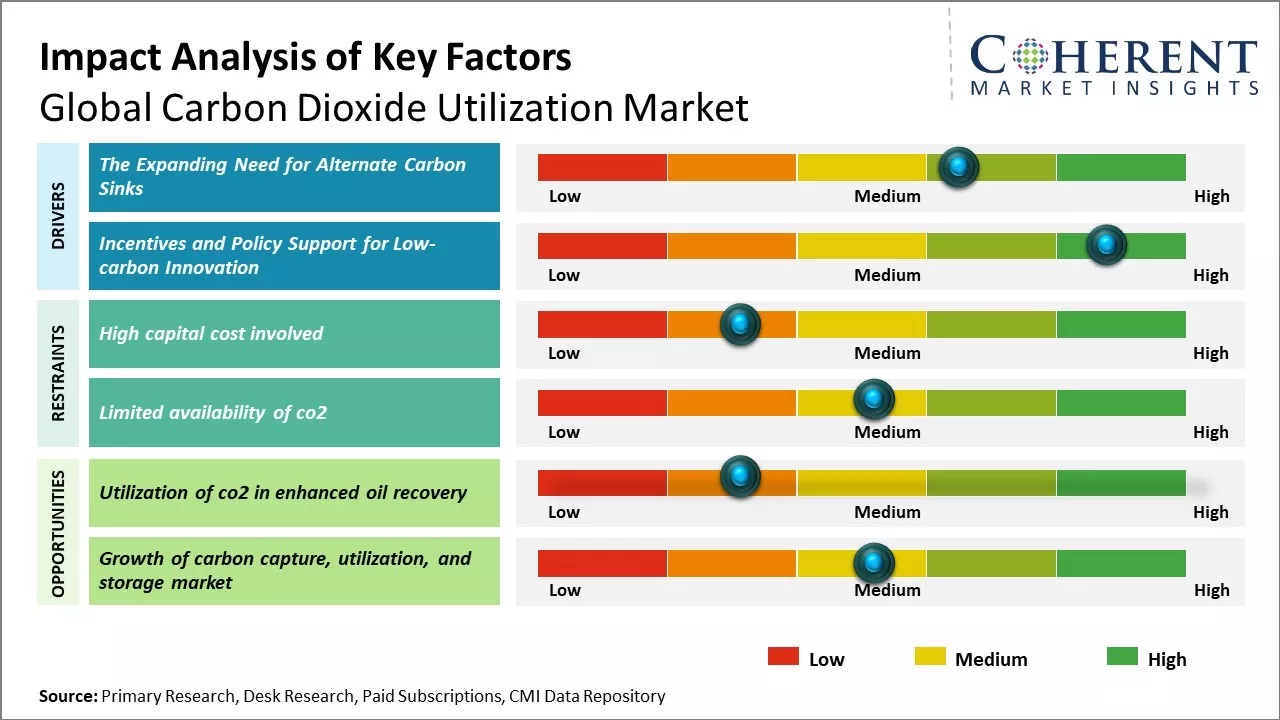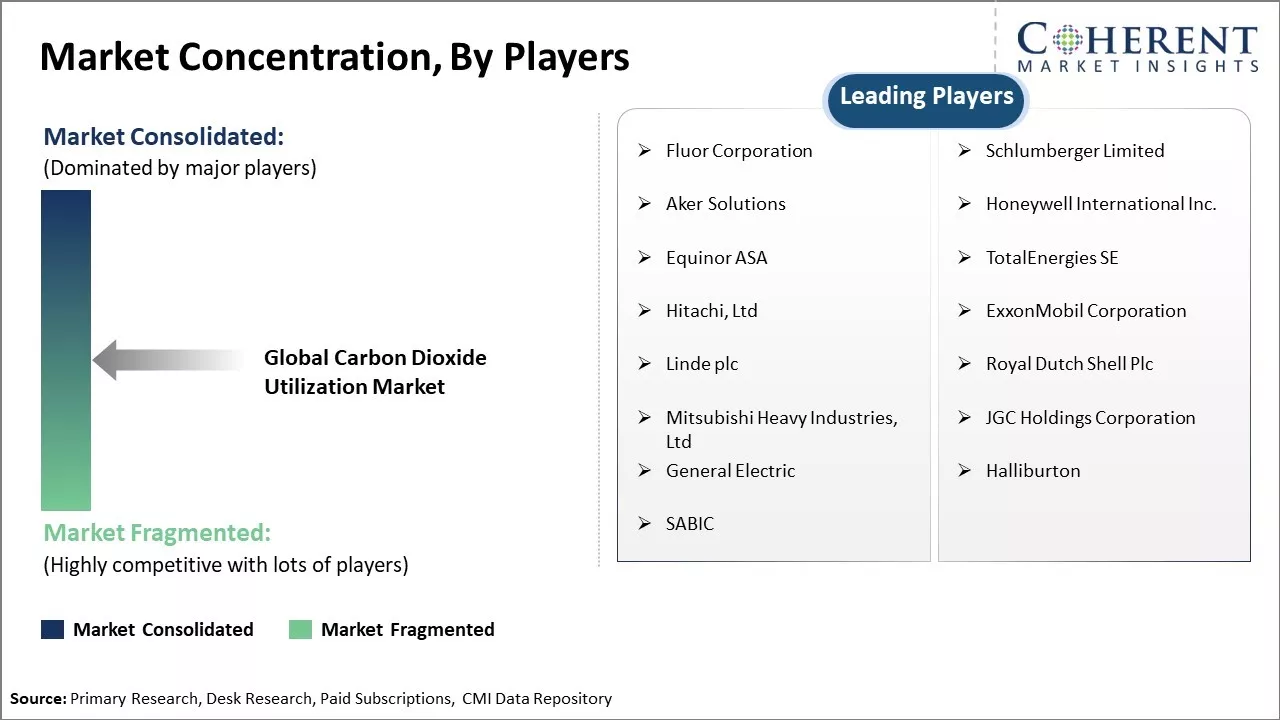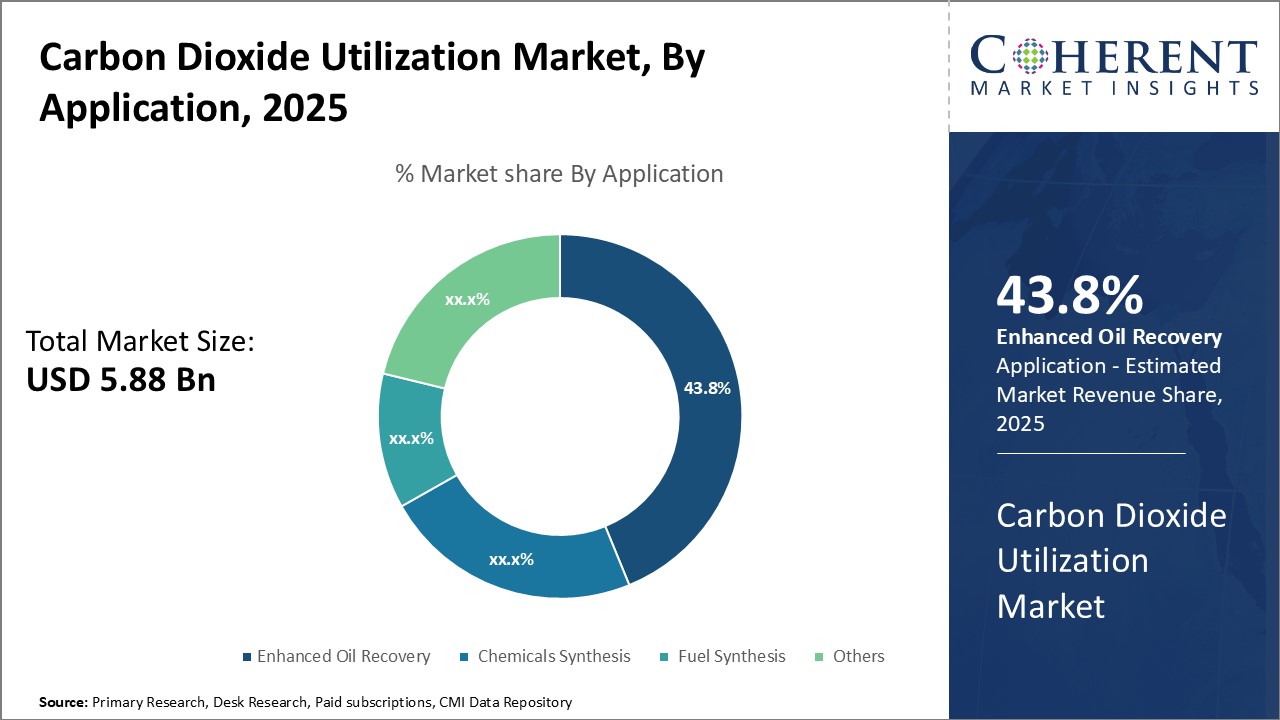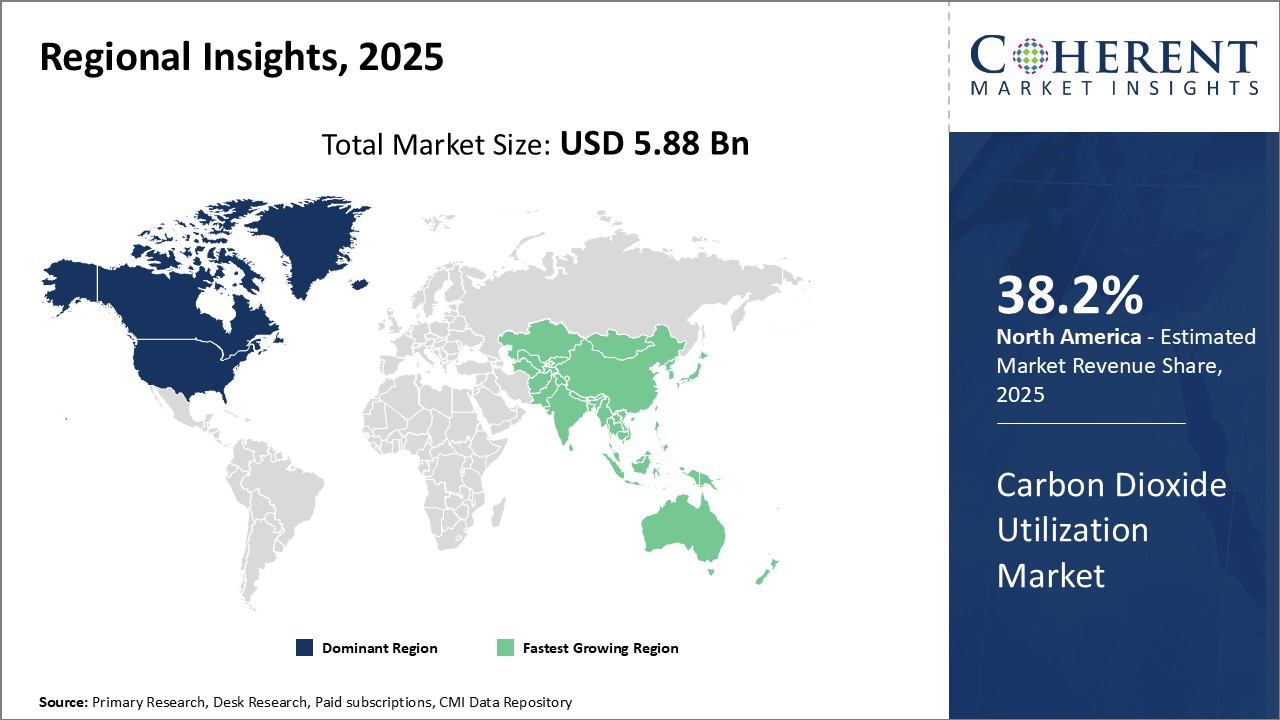Carbon Dioxide Utilization Market Size and Trends
Global carbon dioxide utilization market is estimated to be valued at USD 5.88 Bn in 2025 and is expected to reach USD 14.38 Bn by 2032, exhibiting a compound annual growth rate (CAGR) of 13.6% from 2025 to 2032.

Discover market dynamics shaping the industry: Download Free Sample
Global carbon dioxide utilization market growth can be attributed to increasing efforts globally to reduce emissions and find sustainable alternatives, thus, making carbon dioxide utilization an important part of the solution. Increasing support through regulatory policies and investments in research & development activities can boost demand. Furthermore, growing adoption of carbon dioxide in various end-use industries such as oil & gas, food & beverages, and construction is expected to drive the market growth during the forecast period.
Expanding Need for Alternate Carbon Sinks
The growing climate change concerns across the globe are driving need for alternative solutions to reduce rising carbon dioxide levels in the atmosphere. One such approach gaining prominence is carbon dioxide utilization which aims to enable productive use of CO2 instead of releasing it into the air. The basic idea is to utilize CO2 as a carbon feedstock or raw material in various industrial processes and everyday products. Some of the major application areas where carbon dioxide utilization is being applied include production of fuels like methanol, synthetic gas, construction materials like cement and concrete, plastic and polymer manufacturing, food and beverage sector. Carbon dioxide can act as an inexpensive carbon source and replacing fossil fuels in these areas can significantly help decarbonize many industries. For example, carbon capture technologies coupled with utilization of the captured CO2 is enabling production of building materials like concrete with reduced clinker content but with same or improved durability and strength. The concept of carbon dioxide removal from ambient air through direct air capture technologies and subsequent usage is also gaining ground. The Intergovernmental Panel on Climate Change’s recent report highlighted carbon dioxide removal including utilization as important to achieve climate neutrality by mid-century. The UN Environment Programme's Emissions Gap Report 2021 also stated that carbon dioxide removal volumes must increase over 100-fold by 2050 to limit warming to below 2°C. Growing policy focus on carbon neutrality targets and net-zero emissions goals across regions will require deploying a variety of carbon dioxide management options including usage of the captured carbon.
Market Concentration and Competitive Landscape

Get actionable strategies to beat competition: Download Free Sample
Incentives and Policy Support for Low-carbon InnovationWith the signing of the 2016 Paris Agreement, nearly every country in the world now recognizes the urgent need to transition to a low-carbon future and limit global warming caused by human greenhouse gas emissions. This has prompted many governments to propose and implement policies aimed at stimulating climate innovation. Carbon pricing mechanisms such as emissions trading schemes and carbon taxes explicitly or implicitly place a cost on carbon emissions. Meanwhile, low-carbon research and development is being subsidized through increased public sector funding. Regulatory policies are also promoting low-emissions technologies through performance standards, public procurement programs and mandates on carbon offsetting and reporting. Carbon Utilization ventures stand to benefit significantly from the influx of incentives and supportive policy environments emerging worldwide.
Key Takeaways of Analyst:
Global carbon dioxide utilization market growth is driven by need to reduce CO2 emissions and finding more sustainable ways to reuse carbon that has already been emitted, and rising demand for CO2 utilization technologies. The energy production industry represents a major opportunity as a CO2 source and offers applications like enhanced oil recovery and production of renewable fuels that can permanently store carbon underground. Advancements in CO2 capture technologies also make wider industrial utilization more feasible.
High capital costs associated with developing CO2 utilization infrastructure can hamper the market growth, especially in the early stages of technology adoption. Government policies and regulations along with incentives play a key role in supporting investments. International collaborations will also be important for developing large-scale CO2 value chains. North America is expected to dominate initially due to the presence of major CO2 emission sources and efforts to advance carbon management practices. However, Asia Pacific could see the fastest growth over the long run, driven by the region's growing energy needs and industrial activities.
Market Challenge - High capital cost involved
The high capital cost involved is one of the major factors restraining the growth of the global carbon dioxide utilization market. Setting up infrastructure for carbon dioxide utilization requires huge initial investments. This includes capital expenditures on equipment needed for carbon capture from point sources, its transportation through pipelines, and subsequent conversion into various downstream products. The capital intensity is even higher for technologies in nascent stages of development and commercialization. Significant investments are needed in research and development to lower production costs and enable scaling up of emerging CO2 utilization pathways such as conversion into fuels, chemicals, cement, and carbonated drinks. The high degree of technological and commercial risks associated with these early-stage technologies discourages large capital investments by private entities without adequate government funding support. Achieving economies of scale required to drive down costs further depends on building sufficient capacity over time, which slows down market expansion in the initial years.
Market Opportunity - Utilization of co2 in enhanced oil recovery
Enhanced oil recovery using carbon dioxide has the potential to be a major opportunity area in the global carbon dioxide utilization market. CO2 has been used successfully for decades to extract additional oil from mature oil fields. When injected underground, CO2 increases the mobility of oil and allows more of it to be recovered. This process can potentially extract billions of additional barrels of oil globally that would otherwise remain in the reservoirs. With new investments and advancements in carbon capture, utilization and storage technologies, the volumes of anthropogenic CO2 available for enhanced oil recovery are expected to rise substantially in the coming years.

Discover high revenue pocket segments and roadmap to it: Download Free Sample
Insights, By Application: Harnessing carbon dioxide for enhanced oil recoveryIn terms of application, enhanced oil recovery segment is estimated to contribute the 43.8% share of the market in 2025, owning to the technique's effectiveness in extracting residual oil locked in aging oil fields. When injected into reservoirs that are nearing the end of primary depletion, supercritical carbon dioxide is highly effective at reducing oil viscosity and increasing reservoir pressure, thus, allowing additional crude volumes to be pumped to the surface. Multiple field trials have demonstrated that carbon dioxide-driven EOR can boost recovery rates by 10-15% of original oil in place from mature asset bases. This makes it an appealing option for operators looking to extend the productive lifetime of existing infrastructure and defer field abandonment. As the oil and gas industry prioritizes maximizing asset value amid an energy transition, carbon dioxide EOR is poised to witness growing implementation worldwide.
Insights, By Technology: Capturing potential in post-combustion carbon removal
In terms of technology, post-combustion capture segment is estimated to contribute the 34.8% share of the market in 2025, owing to its applicability to a wide range of emission sources. As flue gases emitted from power generation and industrial facilities have low concentrations of carbon dioxide, post-combustion systems are well-suited for cost-effective separation and purification on those emission streams. Technologies like amine scrubbing that use chemical solvents to selectively remove carbon dioxide from flue gases after fuel combustion have been demonstrated at commercial scale across various applications. With further reductions in capital and operating costs, post-combustion capture plays a key role in lowering carbon footprints for numerous companies across heavy emitters like cement, steel and fossil-based power generation.
Insights, By End User: Carbon solutions in the oil patch
In terms of end user, oil & gas segment is estimated to contribute the 36.1% share of the market in 2025, due to opportunities across multiple segments of the value chain. As the largest single industrial source of carbon dioxide emissions globally, the sector's own operations produce substantial volumes that can be utilized, as in enhanced oil recovery applications. Oil and gas firms also recognize commercial potential in providing carbon management services to other heavy industries. Leveraging core competencies in carbon transportation and sequestration infrastructure developed for EOR, companies plan to offer integrated carbon capture and storage hubs to agricultural, manufacturing and utility customers. Securing long-term carbon dioxide offtake agreements represents a new revenue stream. Overall carbon utilization stands to open promising pathways for the industry's active participation in sustainable solutions.
Regional Insights

Need a Different Region or Segment? Download Free Sample
North America dominates the global carbon dioxide utilization market owing to strong industrial presence and favourable government policies promoting carbon capture utilization and storage (CCUS) technologies in the region with estimated 38.2% share in 2025. Majority of the CCUS capacity additions since 2010 have occurred in the U.S., which is a leader in CO2-EOR projects. Stringent environmental regulations have pushed companies in energy-intensive industries like oil & gas, cement, and power to adopt CCUS to reduce their carbon footprint. The abundant availability of natural reservoirs for CO2 sequestration also makes North America an attractive market.
The Asia Pacific region is primed to be the fastest growing regional market for carbon dioxide utilization in the near future. Rapid industrialization and lack of stringent emissions norms have resulted in Asia Pacific becoming the largest carbon emitting region globally. This has prompted governments in the region to focus more sharply on environmental sustainability. Countries like China and India offer a compelling value proposition for manufacturers as these seek to balance economic growth priorities with climate change commitments.
Market Report Scope
Carbon Dioxide Utilization Market Report Coverage
| Report Coverage | Details | ||
|---|---|---|---|
| Base Year: | 2024 | Market Size in 2025: | USD 5.88 Bn |
| Historical Data for: | 2020 To 2024 | Forecast Period: | 2025 To 2032 |
| Forecast Period 2025 to 2032 CAGR: | 13.6% | 2032 Value Projection: | USD 14.38 Bn |
| Geographies covered: |
|
||
| Segments covered: |
|
||
| Companies covered: |
|
||
| Growth Drivers: |
|
||
| Restraints & Challenges: |
|
||
Uncover macros and micros vetted on 75+ parameters: Get instant access to report
Carbon Dioxide Utilization Industry News
- In May 2024, Mammoth, the largest carbon dioxide capture and storage facility of its kind, launched operations situated on a dormant volcano in Iceland
- In May 2024, ArcelorMittal, MHI launched pilot CO2 capture unit at Gent blast furnace
- In March 2024, a India-based start-up developed an aqueous-based CO2 capture technology comprising a new catalyst that is robust, cost-effective, and scalable. This technology has the capability to capture CO2 in industrial wastewater, marking a significant milestone in the country's transition towards climate-friendly technologies.
- In 2023, New Carbon Dioxide Removal Methodology launched for consultation
*Definition: The Carbon Dioxide Utilization Market involves technologies and processes that capture and reuse carbon dioxide (CO2) emissions instead of releasing them into the atmosphere. This includes using CO2 to manufacture products like polymers, chemicals and fuels through chemical conversion. It also includes technologies like algae growth that converts CO2 into biomass, mineralization processes that turn CO2 into inorganic carbonates, and photosynthesis enhancement systems for agriculture that improve plant growth using CO2.
Market Segmentation
- Application Insights (Revenue, USD Bn, 2020 - 2032)
- Enhanced Oil Recovery
- Chemicals Synthesis
- Fuel Synthesis
- Others
- Technology Insights (Revenue, USD Bn, 2020 - 2032)
- Pre-Combustion Capture
- Oxy-Fuel Combustion Capture
- Post-Combustion Capture
- End User Insights (Revenue, USD Bn, 2020 - 2032)
- Oil & Gas
- Power Generation
- Iron & Steel
- Chemical & Petrochemical
- Others
- Regional Insights (Revenue, USD Bn, 2020 - 2032)
- North America
- U.S.
- Canada
- Latin America
- Brazil
- Argentina
- Mexico
- Rest of Latin America
- Europe
- Germany
- U.K.
- Spain
- France
- Italy
- Russia
- Rest of Europe
- Asia Pacific
- China
- India
- Japan
- Australia
- South Korea
- ASEAN
- Rest of Asia Pacific
- Middle East & Africa
- GCC Countries
- Israel
- Rest of Middle East & Africa
- North America
- Key Players Insights
- Fluor Corporation
- Schlumberger Limited
- Aker Solutions
- Honeywell International Inc.
- Equinor ASA
- TotalEnergies SE
- Hitachi, Ltd
- ExxonMobil Corporation
- Linde plc
- Royal Dutch Shell Plc
- Mitsubishi Heavy Industries, Ltd
- JGC Holdings Corporation
- General Electric
- Halliburton
- SABIC
Share
Share
About Author
Yash Doshi is a Senior Management Consultant. He has 12+ years of experience in conducting research and handling consulting projects across verticals in APAC, EMEA, and the Americas.
He brings strong acumen in helping chemical companies navigate complex challenges and identify growth opportunities. He has deep expertise across the chemicals value chain, including commodity, specialty and fine chemicals, plastics and polymers, and petrochemicals. Yash is a sought-after speaker at industry conferences and contributes to various publications on topics related commodity, specialty and fine chemicals, plastics and polymers, and petrochemicals.
Missing comfort of reading report in your local language? Find your preferred language :
Transform your Strategy with Exclusive Trending Reports :
Frequently Asked Questions
EXISTING CLIENTELE
Joining thousands of companies around the world committed to making the Excellent Business Solutions.
View All Our Clients
